CORNELL HISTORY
Cornell and the Big Apple go way back
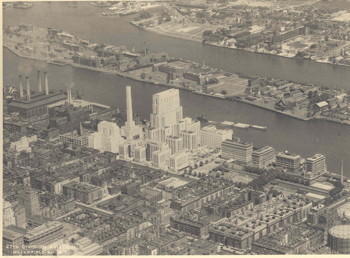
New York Hospital-Cornell Medical Center aerial view, 1930s. All Weill Cornell images: Courtesy of Medical Center Archives of NewYork-Presbyterian/Weill Cornell. See larger image
Although Ezra Cornell spent his later years building his legacy on Ithaca's East Hill, his story began in the present-day Bronx, nearly 200 miles away. From Ezra's birth at Westchester Landing in 1807 to the announcement of the Cornell NYC Tech campus's founding more than 200 years later, our alma mater's history has been entwined with the New York metropolitan area.
The tech campus, to be located on Roosevelt Island, will join the university's other New York City locations and brings Cornell University full circle, with a new campus to be built less than 10 miles from Ezra Cornell's birthplace.
As a child, Cornell lived in Tarrytown, West Farms (Bronx) and New Jersey's Bergen County before moving to the upstate New York town of DeRuyter with his family at the age of 11 and then to Ithaca a decade later. But his business travels would bring him downstate long before he dreamed of founding a great university. In 1844, tasked with finding investors for the newly invented telegraph, Cornell returned to New York City in search of capital. He constructed a telegraph line from 112 Broadway (near Trinity Church) to 561 Broadway (near Prince Street) as part of an exhibition but received limited attention from the public.
With little income, Cornell often skipped meals and slept on chairs in the exhibition room. However, his hardship would eventually pay off, and the telegraph would make him a wealthy man, helping fund his eponymous university in Ithaca just over two decades later.
In 1867, Ezra Cornell and university co-founder Andrew Dickson White turned to New York City talent for help in designing and planning the new campus that would replace Cornell's farm in Ithaca. White contacted Frederick Law Olmsted, known as the "father of American landscape architecture," who had recently co-designed New York's Central Park. Olmsted's plan cautioned against the rigid confines of a quadrangle, but he eventually went along with White's vision. His most lasting contribution may be the recommendation that White Hall be built on the same elevation as Morrill Hall to create a unified skyline.
1898: Medical college established
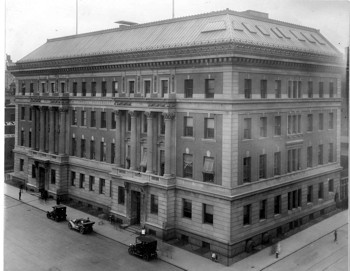
Cornell University Medical College's first building, ca. 1910. See larger image
Cornell University's first major academic unit to be established in New York City was the College of Medicine in 1898. The new college formed following a disagreement over New York University's management of its University Medical College and the affiliated Bellevue Hospital Medical College. Unhappy with policies and a lack of representation in matters of governance and appointments, many of the University Medical College and Bellevue faculty and students seceded from NYU to create Cornell's College of Medicine, which soon moved to a new building on First Avenue between 27th and 28th streets, funded by an endowment from businessman Oliver H. Payne.
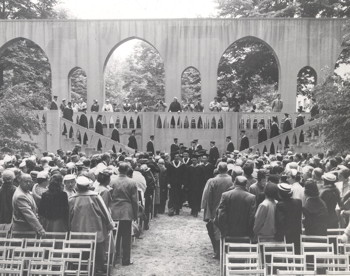
Graduation ceremonies for the Cornell University Medical College Class of 1955. See larger image
Although Cornell medical students are a rare sight in Ithaca today, the first two years of medical courses were offered on campus in Stimson Hall as well as in New York until the Ithaca division was closed in 1938. Over the next century, the college would expand through affiliation with New York Hospital in 1912 and the opening of the New York Hospital-Cornell Medical Center in 1932. The Cornell University-New York Hospital School of Nursing joined the medical school in 1942 but closed in 1979 due to funding issues. In 1998, the generosity of Sanford I. Weill '55 and wife Joan led to the formal renaming of the medical school as the Joan and Sanford I. Weill Medical College of Cornell University.
Alumni in NYC
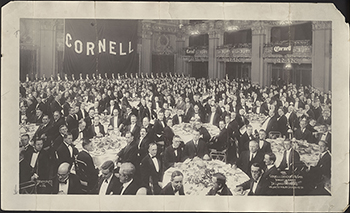
The Cornell Club of New York held a testimonial dinner and banquet in honor of Dr. Livingston Farrand, Cornell's new president, at the Waldorf-Astoria Hotel in New York City in December 1921. According to the Cornell Era, the event "set the high water mark for all time of Cornell alumni enthusiasm in New York City" and set a record for attendance at an alumni gathering as 716 Cornellians filled the hotel's grand ballroom. Photo: Division of Rare and Manuscript Collections.
Cornell University alumni in New York City were among the first to organize, and the Cornell University Club of New York was incorporated in 1889. In 1909 the association opened its first clubhouse at 65 Park Ave., complete with parlors, reading and billiard rooms, a café and a dining room. In 1933 it added a satellite office of the University Placement Bureau to help alumni find jobs. The club would relocate many times over the years, eventually opening its current location at 6 E. 44th St. in 1989. Today, the university operates numerous offices in the city for Cornell Financial Engineering Manhattan; the College of Architecture, Art and Planning; the ILR School; Cornell University Cooperative Extension-NYC; and the Division of Alumni Affairs and Development.
A list of all the Cornell collaborations and programs operating in New York City would fill the pages of this magazine and beyond. As the "beta" class of students begin their studies at Cornell NYC Tech, Ezra Cornell's legacy in the Big Apple has broadened yet further. The new campus is poised to make a significant impact in the city and worldwide, continuing Cornell's role as the "land-grant university to the world."
Corey Ryan Earle '07 is associate director of student programs in the Office of Alumni Affairs.
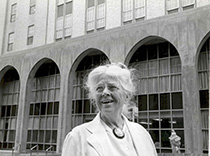
Connie Guion See larger image
Notable medical school Cornellians
Emily Dunning Barringer, M.D. 1901 – First female ambulance surgeon and surgical resident; American Medical Women's Association president.
Connie Guion, M.A. '13, M.D. '17 – professor of clinical medicine and a pioneer among women doctors. In 1963, New York Hospital's Connie Guion Building was dedicated – the first building named in honor of a living woman physician.
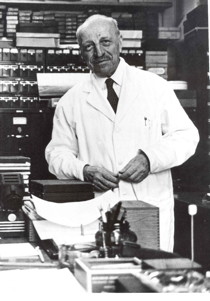
George N. Papanicolaou See larger image
Henry Heimlich, A.B. 1941, M.D. 1943 – Developer of the Heimlich maneuver.
C. Everett Koop, M.D. 1941 – Surgeon general of the United States, 1981-89.
George N. Papanicolaou, professor of clinical anatomy – Pioneer in cytopathology and developer of the "Pap smear."
Vincent du Vigneaud, professor of biochemistry – Awarded the 1955 Nobel Prize in chemistry for the synthesis of oxytocin.
Notable Cornellian New Yorkers
George F. Baker, trustee, Baker laboratory and dormitories namesake – President and chair of the First National Bank of New York (now Citibank), Baker was an influential man in business and philanthropy. In addition to his significant gifts to Cornell, he helped fund Baker Library at Dartmouth, Baker Field at Columbia and the Harvard Business School.
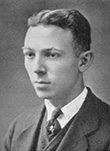
E.B. White, Class of 1921. See larger image
George C. Boldt, trustee, Boldt Hall namesake – Boldt merged the Waldorf and Astoria hotels together, serving as proprietor of the new Waldorf-Astoria Hotel, which often hosted Cornell trustee meetings under his management. He also is credited with popularizing Thousand Island dressing.
Richmond H. Shreve, Class of 1902 – An architect with Shreve, Lamb and Harmon, the firm that designed the Empire State Building, Shreve was also lead architect for the Williamsburg Houses in Brooklyn.
E.B. White, Class of 1921 – A longtime contributor to The New Yorker, White also authored the book "Here Is New York," which has been called a "love letter" to the city.
